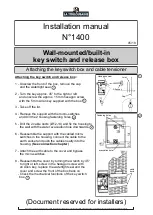
CHAPTER 6: OPERATIONAL GUIDE
OPERATIONAL GUIDE
MULTINET4 MULTI-PORT SERIAL SERVER & MANAGED SWITCH – INSTRUCTION MANUAL
6–9
the same LAN you can determine which bridge will become the designated bridge
by setting its priority value low.
• H
ello Time –
The default Hello Time value is 2 seconds (in a valid range of 1-10).
The manually configurable Hello Time value applies to the root bridge. A smaller
Hello Time value will result in quicker detection of topology changes but it will also
result in increased traffic on the system. Designated bridges use a Hello Time
learned from BPDUs sent from the root bridge.
•
Forward Delay –
The default Forward Delay value is 15 seconds (in a valid range of
4-30). A shorter Forward Delay may result in quicker adaptation to topology
changes. Designated bridges use a Forward Delay learned from BPDUs sent from
the root bridge.
•
Maximum Age –
The default Maximum Age value is 20 seconds (in a valid range of
6-40). In a network that includes some slow links it could be useful to set a higher
value for Maximum Age.
•
Cost Style –
Specifies whether 16-bit (STP-style) or 32-bit (RSTP-style) path cost
values are used.
6.3.3.2 Configuring Port Settings
Use the
4.4.3.2: RSTP: Port Settings
screen to configure the following parameters:
•
Mode –
•
Point – Specify that any port that connects to another switch that uses
RSTP is a point port.
•
Edge – Specify that any port that connects to and end station is an Edge
port. This allows direct transition to forwarding and prevents
unnecessary topology change messages.
•
Legacy – Specify that a port that uses STP only is a legacy port.
•
Port Priority –
The default Port Priority value is 128 (in a valid range of 0-255). The
RSTP protocol will select root, designated, and backup ports from among
redundant ports on a bridge based on the port ID and the priority settings. To force
the selection of a specific port as the root port give it a low priority value.
















































